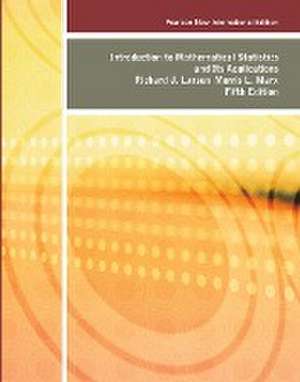Introduction to Mathematical Statistics and Its Applications
Autor Morris Marx, Richard Larsenen Limba Engleză Paperback – 5 aug 2013
Preț: 534.24 lei
Preț vechi: 614.07 lei
-13% Nou
Puncte Express: 801
Preț estimativ în valută:
102.24€ • 106.09$ • 85.45£
102.24€ • 106.09$ • 85.45£
Carte indisponibilă temporar
Doresc să fiu notificat când acest titlu va fi disponibil:
Se trimite...
Preluare comenzi: 021 569.72.76
Specificații
ISBN-13: 9781292023557
ISBN-10: 1292023554
Pagini: 744
Ilustrații: Illustrations (black and white)
Dimensiuni: 216 x 271 x 38 mm
Greutate: 1.78 kg
Ediția:5. Auflage
Editura: Pearson Education
ISBN-10: 1292023554
Pagini: 744
Ilustrații: Illustrations (black and white)
Dimensiuni: 216 x 271 x 38 mm
Greutate: 1.78 kg
Ediția:5. Auflage
Editura: Pearson Education
Cuprins
1. Introduction
1.1 An Overview
1.2 Some Examples
1.3 A Brief History
1.4 A Chapter Summary
2. Probability
2.1 Introduction
2.2 Sample Spaces and the Algebra of Sets
2.3 The Probability Function
2.4 Conditional Probability
2.5 Independence
2.6 Combinatorics
2.7 Combinatorial Probability
2.8 Taking a Second Look at Statistics (Monte Carlo Techniques)
3. Random Variables
3.1 Introduction
3.2 Binomial and Hypergeometric Probabilities
3.3 Discrete Random Variables
3.4 Continuous Random Variables
3.5 Expected Values
3.6 The Variance
3.7 Joint Densities
3.8 Transforming and Combining Random Variables
3.9 Further Properties of the Mean and Variance
3.10 Order Statistics
3.11 Conditional Densities
3.12 Moment-Generating Functions
3.13 Taking a Second Look at Statistics (Interpreting Means)
Appendix 3.A.1 MINITAB Applications
4. Special Distributions
4.1 Introduction
4.2 The Poisson Distribution
4.3 The Normal Distribution
4.4 The Geometric Distribution
4.5 The Negative Binomial Distribution
4.6 The Gamma Distribution
4.7 Taking a Second Look at Statistics (Monte Carlo Simulations)
Appendix 4.A.1 MINITAB Applications
Appendix 4.A.2 A Proof of the Central Limit Theorem
5. Estimation
5.1 Introduction
5.2 Estimating Parameters: The Method of Maximum Likelihood and the Method of Moments
5.3 Interval Estimation
5.4 Properties of Estimators
5.5 Minimum-Variance Estimators: The Cramér-Rao Lower Bound
5.6 Sufficient Estimators
5.7 Consistency
5.8 Bayesian Estimation
5.9 Taking A Second Look at Statistics (Beyond Classical Estimation)
Appendix 5.A.1 MINITAB Applications
6. Hypothesis Testing
6.1 Introduction
6.2 The Decision Rule
6.3 Testing Binomial Data-H0: p = po
6.4 Type I and Type II Errors
6.5 A Notion of Optimality: The Generalized Likelihood Ratio
6.6 Taking a Second Look at Statistics (Statistical Significance versus "Practical" Significance)
7. Inferences Based on the Normal Distribution
7.1 Introduction
7.2 Comparing Y-µ s/ vn and Y-µ S/ vn
7.3 Deriving the Distribution of Y-µ S/ vn
7.4 Drawing Inferences About µ
7.5 Drawing Inferences About s2
7.6 Taking a Second Look at Statistics (Type II Error)
Appendix 7.A.1 MINITAB Applications
Appendix 7.A.2 Some Distribution Results for Y and S2
Appendix 7.A.3 A Proof that the One-Sample t Test is a GLRT
Appendix 7.A.4 A Proof of Theorem 7.5.2
8. Types of Data: A Brief Overview
8.1 Introduction
8.2 Classifying Data
8.3 Taking a Second Look at Statistics (Samples Are Not "Valid"!)
9. Two-Sample Inferences
9.1 Introduction
9.2 Testing H0: µX =µY
9.3 Testing H0: s2X=s2Y-The F Test
9.4 Binomial Data: Testing H0: pX = pY
9.5 Confidence Intervals for the Two-Sample Problem
9.6 Taking a Second Look at Statistics (Choosing Samples)
Appendix 9.A.1 A Derivation of the Two-Sample t Test (A Proof of Theorem 9.2.2)
Appendix 9.A.2 MINITAB Applications
10. Goodness-of-Fit Tests
10.1 Introduction
10.2 The Multinomial Distribution
10.3 Goodness-of-Fit Tests: A
1.1 An Overview
1.2 Some Examples
1.3 A Brief History
1.4 A Chapter Summary
2. Probability
2.1 Introduction
2.2 Sample Spaces and the Algebra of Sets
2.3 The Probability Function
2.4 Conditional Probability
2.5 Independence
2.6 Combinatorics
2.7 Combinatorial Probability
2.8 Taking a Second Look at Statistics (Monte Carlo Techniques)
3. Random Variables
3.1 Introduction
3.2 Binomial and Hypergeometric Probabilities
3.3 Discrete Random Variables
3.4 Continuous Random Variables
3.5 Expected Values
3.6 The Variance
3.7 Joint Densities
3.8 Transforming and Combining Random Variables
3.9 Further Properties of the Mean and Variance
3.10 Order Statistics
3.11 Conditional Densities
3.12 Moment-Generating Functions
3.13 Taking a Second Look at Statistics (Interpreting Means)
Appendix 3.A.1 MINITAB Applications
4. Special Distributions
4.1 Introduction
4.2 The Poisson Distribution
4.3 The Normal Distribution
4.4 The Geometric Distribution
4.5 The Negative Binomial Distribution
4.6 The Gamma Distribution
4.7 Taking a Second Look at Statistics (Monte Carlo Simulations)
Appendix 4.A.1 MINITAB Applications
Appendix 4.A.2 A Proof of the Central Limit Theorem
5. Estimation
5.1 Introduction
5.2 Estimating Parameters: The Method of Maximum Likelihood and the Method of Moments
5.3 Interval Estimation
5.4 Properties of Estimators
5.5 Minimum-Variance Estimators: The Cramér-Rao Lower Bound
5.6 Sufficient Estimators
5.7 Consistency
5.8 Bayesian Estimation
5.9 Taking A Second Look at Statistics (Beyond Classical Estimation)
Appendix 5.A.1 MINITAB Applications
6. Hypothesis Testing
6.1 Introduction
6.2 The Decision Rule
6.3 Testing Binomial Data-H0: p = po
6.4 Type I and Type II Errors
6.5 A Notion of Optimality: The Generalized Likelihood Ratio
6.6 Taking a Second Look at Statistics (Statistical Significance versus "Practical" Significance)
7. Inferences Based on the Normal Distribution
7.1 Introduction
7.2 Comparing Y-µ s/ vn and Y-µ S/ vn
7.3 Deriving the Distribution of Y-µ S/ vn
7.4 Drawing Inferences About µ
7.5 Drawing Inferences About s2
7.6 Taking a Second Look at Statistics (Type II Error)
Appendix 7.A.1 MINITAB Applications
Appendix 7.A.2 Some Distribution Results for Y and S2
Appendix 7.A.3 A Proof that the One-Sample t Test is a GLRT
Appendix 7.A.4 A Proof of Theorem 7.5.2
8. Types of Data: A Brief Overview
8.1 Introduction
8.2 Classifying Data
8.3 Taking a Second Look at Statistics (Samples Are Not "Valid"!)
9. Two-Sample Inferences
9.1 Introduction
9.2 Testing H0: µX =µY
9.3 Testing H0: s2X=s2Y-The F Test
9.4 Binomial Data: Testing H0: pX = pY
9.5 Confidence Intervals for the Two-Sample Problem
9.6 Taking a Second Look at Statistics (Choosing Samples)
Appendix 9.A.1 A Derivation of the Two-Sample t Test (A Proof of Theorem 9.2.2)
Appendix 9.A.2 MINITAB Applications
10. Goodness-of-Fit Tests
10.1 Introduction
10.2 The Multinomial Distribution
10.3 Goodness-of-Fit Tests: A
